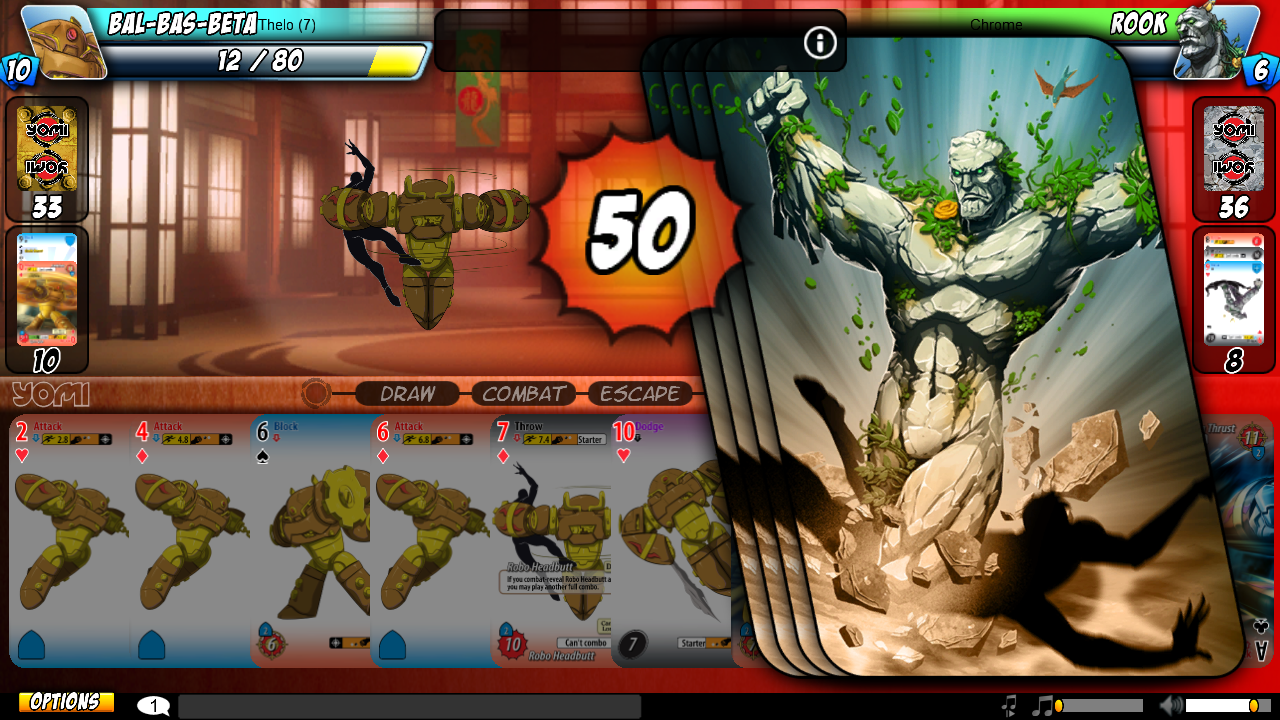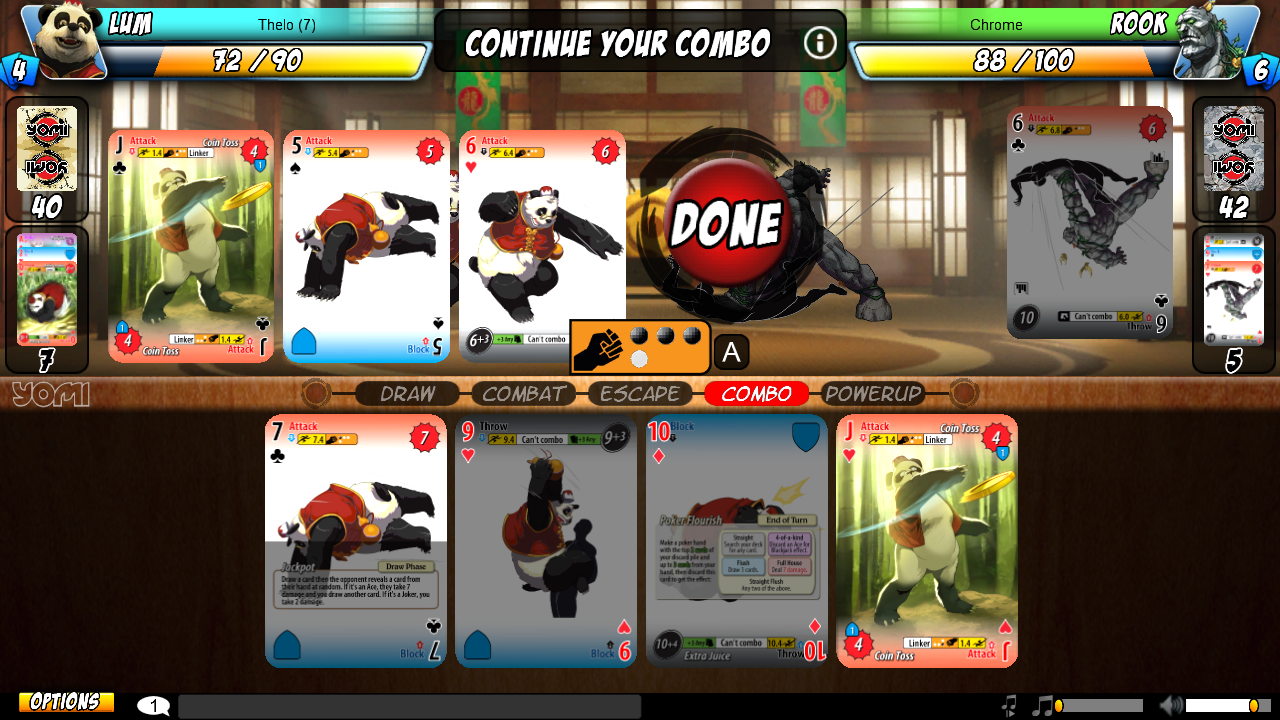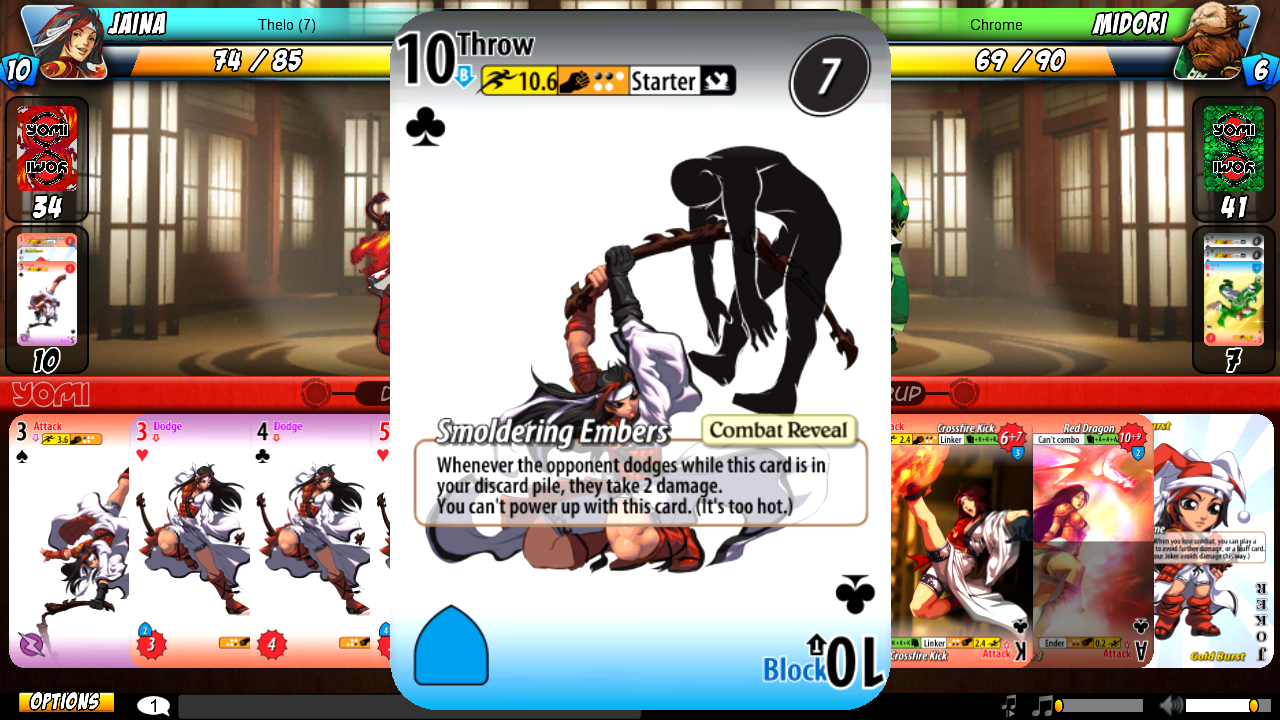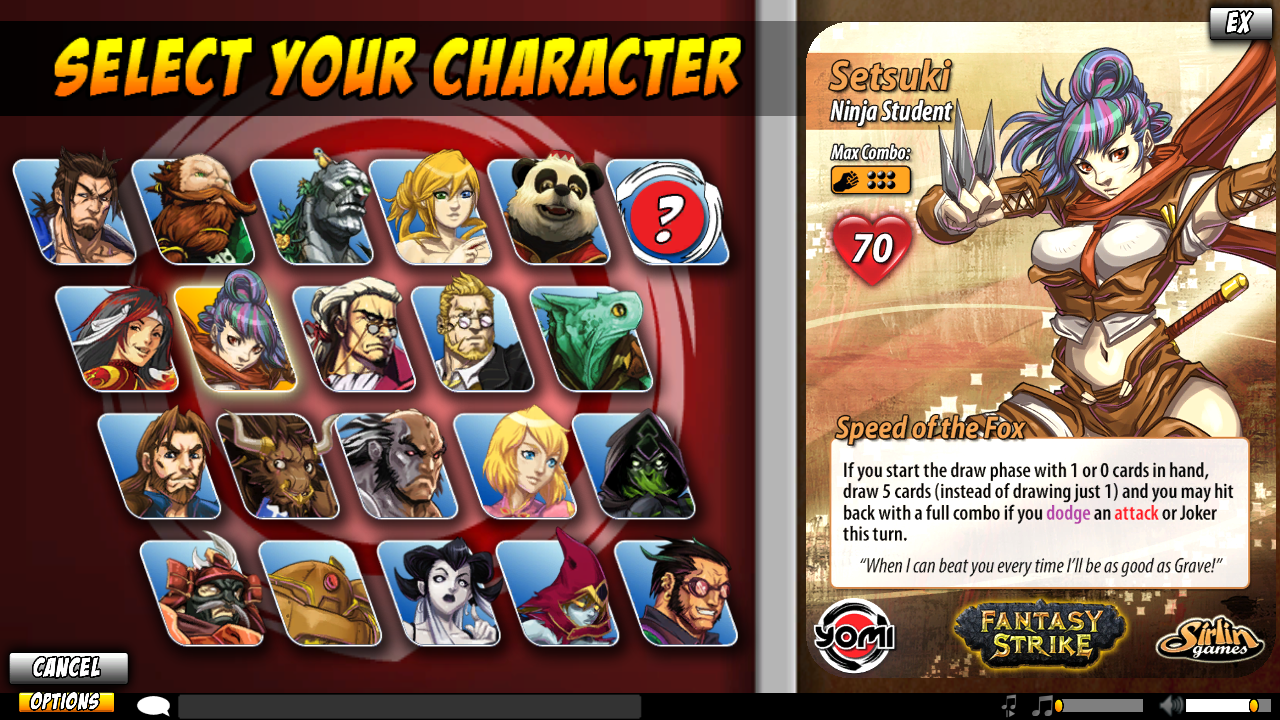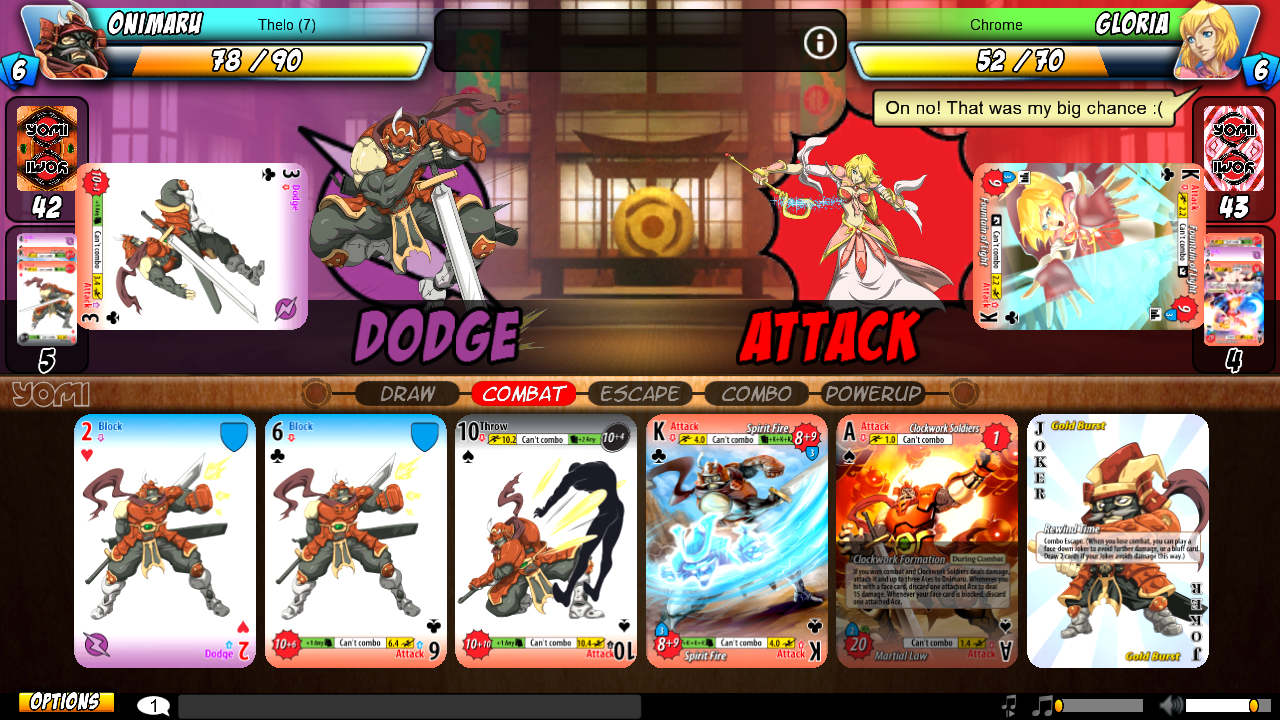I think my earlier self would say "fewer moves sounds like a bad idea!" And even my current self wouldn't say that the number of moves in a game like Rising Thunder is bad. It's fine! But the thing I've discovered in the last year is that you can do a whole lot with very little. Divekick is really the pioneer game here. It started as a joke game, but ended up proving that you can have a whole lot of gameplay in a game with no joystick at all and just two buttons: jump and attack. A really surprising amount of gameplay. (Shoutout to Keits: good job!) That really shifted my thinking around and I started thinking in terms of "if a game had EVEN MORE stuff than Divekick, just imagine how much there could be to it." By carefully crafting move design and making sure moves have several different uses, it turns out that radically simplifying the genre still preserves the core of what's good about it. It still FEELS like a fighting game with frame traps, combos, okizeme (pressure against a knocked down opponent), and so on. But it controls so amazingly simply that you can pick it up and play immediately.
I've been pleasantly surprised to see some players who are generally not that great at fighting games have been able to have pretty exciting matches with me. The setups, the tricks, and even the combos are basically immediately accessible to them, so they are playing the real game within minutes. Even though these same people might struggle with getting consistent special moves in Street Fighter, I now see that at least a couple of them always had the head for these types of games, just not the hands, ha. I'm glad to bring them into the fold.
Mac / PC
It seems both Fantasy Strike and Rising Thunder will have a solid focus on the PC platform. That is, not an afterthought port. We've had Mac builds as well as PC builds from day 1 on Fantasy Strike, though I can't comment on other platforms right now. Anyway, one noteworthy thing about the Mac / PC platform is keyboard control. Fighting game tournaments are a sea of joysticks. Playing a fighting game on a keyboard is a generally awful thing...unless you redesign the control system to eliminate 360s, half circles, quarter circles, dragon punch motions, and so on. Then you're just pressing individual buttons, and it works a lot better. Fantasy Strike goes even further by demanding only two keys from your left hand: move left and move right. You don't even need to map up or down, as your right hand can press the jump, attack, and special buttons. (We could certainly add more to our controls scheme if we need to, but so far it's gone over fantastically in playtesting exactly how it is.)
What's neat is that these simplified control schemes work very well on a stick, very well on a pad, AND very well on keyboard. So it seems both Fantasy Strike and Rising Thunder have zeroed in on that concept, that making simpler controls doesn't JUST make the interesting parts of the game more accessible, it ALSO makes physical equipment you need to play the game more accessible. Everyone has a keyboard and it works great for these games!
Online
Rising Thunder deserves very special mention here for having Tony Cannon behind it, the creator of the awesome GGPO networking system. I was actually one of the first players (the very first?) to test GGPO back in the day. I remember that my feedback on his first pass which had really no optimizations and no other testing at all was that it was noticeably better than any other fighting game networking I had ever used. Tony was very excited to hear that because he said there were all sorts of things he could do make online even less laggy feeling. He of course went on to do just that and, using the "rollback" technique, created hands-down the best online tech for fighting games. If there's one thing you can be sure of, it's that Rising Thunder is going to have fantastic networking from a technical standpoint.
And of course Fantasy Strike will use rollback networking as well, hopefully with GGPO. There's just no other acceptable way to do it, and it's totally baffling that rollback networking wasn't already a standard 10 years ago, much less in 2015.
Even though the technical implementation of online play is SUPER important, I think there's a lot more room for improvement even beyond that when it comes to online play. The whole way it's presented in fighting games is really very confusing and junky. Any kind of design thing that is confusing and junky drives me nuts, but this subject really deserves special mention because the effects are much bigger than if, say, button config is confusing and junky (which would also be horrible!). Anyway when there's any friction to how you actually go about playing online, that reduces the pool of opponents, increases wait times, and the cycle can compound until there just isn't anyone online.
Other genres are really miles beyond fighting games when it comes to this stuff. It's time for us to step up and streamline not just special moves and control systems, but also the overall experience of playing online.
Gameplay
Even though Fantasy Strike and Rising Thunder come from such similar origins and have such similar principles to them, the actual feel of the games will be quite different. So while it's an interesting hook how on-the-same-page these two games are with each other in so many ways, it will be equally interesting to see where they diverge.
Unfortunately, I can't say much more about that right now, but I will say that Fantasy Strike has a different take on throw escapes than the rest of the genre and I've waited literally over 10 years now to put it into a game. I'll hold off on more gameplay details because Fantasy Strike is still very early in development. I'm just happy that there's going to be some new entries in the fighting game genre that will each do their part in spreading the love of what's so fun about the genre to a whole new set of people who have been left behind so far.
When the team over at Radiant (lead by Evolution founder Tom Cannon, by the way) and I are both working so hard toward the same kind of ends on separate projects, it really does feel like a new era of fighting games is on the horizon. An inclusive era that is going to expand the genre while keeping their wonderful strategic nature intact. If anything, the focus in these games is going to be on strategy more than ever, and less on 1p training mode. While some are going to call that dumbed down for casuals, it's actually the opposite of dumbing down to put more emphasis on player-decisions.
Patreon
If you'd like to support my game development and podcasts, you can become a patron at patreon.com/sirlin. The higher tier patrons are already playing my customizable card game Codex (tabletop version) and a 1-character prototype build of the Fantasy Strike fighting game showing the gameplay without real art. There will be a new build there next week with a second character. I stress to any potential patrons that we're letting you in on things way, way early and have focused entirely on gameplay and are only showing builds with extremely rough art for now which will all be updated with "real" art as we go. Come on board if you'd like to help support the development of the game all the way through.
I think it's a great time for the genre, and the times they are a-changin'.




















